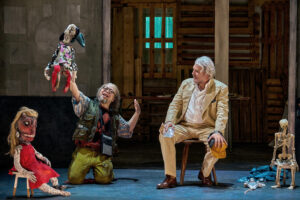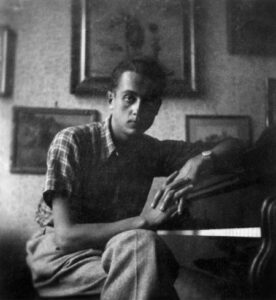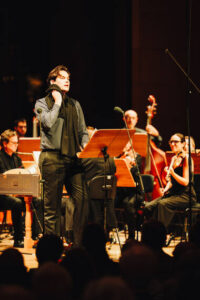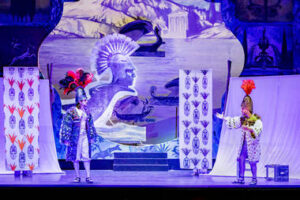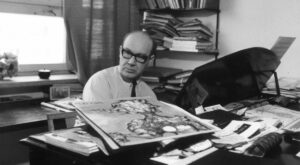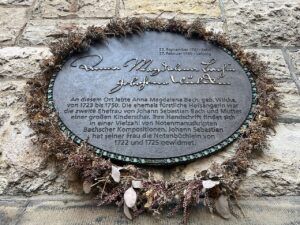Byle dalej od polityki
No i wszystko jasne. W ubiegłym sezonie recenzowałam dwie pierwsze części Pierścienia Nibelunga w Bayreuth – w reżyserii Valentina Schwarza – w tym roku, zgodnie z obietnicą, skorzystałam z okazji, by dokończyć dzieła. Było to ostateczne pożegnanie z kontrowersyjną inscenizacją młodego Austriaka. W 2026, na jubileusz 150-lecia prapremiery tetralogii, Bayreuther Festspiele zapowiadają kolejny eksperyment: Der Ring in Bewegung, czyli Pierścień w ruchu, przygotowany przez istną armię realizatorów, którzy nakarmią sztuczną inteligencję „wspomnieniami” z dotychczasowych produkcji na Zielonym Wzgórzu i pozwolą jej „reżyserować” na ich podstawie nowe spektakle, za każdym razem odrobinę inne: w dekoracjach zaprojektowanych przez Wolfa Gutjahra i ze śpiewakami ubranymi w kostiumy autorstwa Pii Marii Mackert. Nikt nie próbuje się nawet domyślać, jak to będzie wyglądało. Przypuszczam, że sami twórcy szykują się na mnóstwo niespodzianek. Wielu bywalców cieszy się jednak z powrotu Christiana Thielemanna za pulpit dyrygencki oraz kilku istotnych zmian w obsadzie.
Przez cztery lata od premiery koncepcja Schwarza ulegała kolejnym modyfikacjom – w minionym sezonie podobno najgłębszym. Niestety, nie mogę ocenić ich obiektywnie, bo każdy z członów Ringu widziałam tylko raz. Lecz jeśli nawet udało się dopracować kilka pomysłów i zwiększyć spójność poszczególnych scen, dziecinna skłonność reżysera do podejmowania efektownych wątków narracyjnych i raptownego ich porzucania sprowadziła go na kompletne manowce. Parafrazując słynną zasadę kompozycyjną Czechowa, żadna z dziesiątków dramaturgicznych strzelb z prologu nie wystrzeliła w Zmierzchu bogów, a to, co tam w finale wystrzeliło, okazało się bronią na ślepaki. Natłok symboli zbędnych i całkowita nieobecność symboli istotnych wprawiały w konfuzję nie tylko publiczność, lecz i krzątających się po scenie wykonawców. Rok temu zastanawiałam się, co albo kto jest Złotem Renu. Doszłam do spójnego z opiniami innych odbiorców wniosku, że koszmarny bachor porwany Córom Renu znad basenu w pierwszej części Pierścienia. I miałam rację, albo jej nie miałam, bo wprowadzony przez Schwarza w tej roli mały Hagen – który z punktu widzenia logiki narracji w ogóle nie powinien był się pojawić w Złocie Renu – ostatecznie zawodzi jako narzędzie zagłady i ponownego odrodzenia świata. Chyba że uznać, iż całkiem już dorosły Hagen stał się niespodziewanie „skarbem” Brunhildy, która w finale traci zainteresowanie martwym Zygfrydem i namiętnie wpija się w usta jego mordercy. To jednak sugeruje, że wszechświat wpadł w spiralę przemocy i nic się już nigdy nie naprawi. Tymczasem w zgliszcza Walhalli, czyli w smętną kałużę i ledwie pełgające ogniki, wkracza odmłodzone wcielenie Erdy w zaawansowanej ciąży, a noszone przez nią bliźnięta (przypomnijmy, w wersji reżysera skłócony z Wotanem Alberyk jest jego bliźniakiem), ujrzymy za chwilę w projekcji scenicznej. Tym razem splecione w uścisku i uśmiechnięte od ucha do ucha.
Ludzkimi i martwymi rekwizytami Schwarz manipuluje bez ładu i składu. Tajemniczy ostrosłup może być wszystkim – ogniem Logego, stosem pogrzebowym albo siedzibą bogów. Nie zdziwiłabym się jednak, gdyby w rozwichrzonej koncepcji reżysera okazał się niczym więcej, jak lampką nocną. Zagadkowa kostka Rubika z poprzednich części pełni w Zygfrydzie funkcję czysto ornamentacyjną, dyndając na szyi podrośniętego już Hagena. Nothung objawia się dopiero w trzeciej części tetralogii, wyciągnięty przez Zygfryda z kuli inwalidzkiej Mimego i jako żywo niewymagający przekuwania. Być może dlatego bohater oddaje się robocie kowalskiej w głębi sceny, ukryty przed wzrokiem widowni, a iskry sypią się z całkiem innej strony.
Zygfryd. Ya-Chung Huang (Mime) i Tomasz Konieczny (Wędrowiec). Fot. Enrico Nawrath
Absurdy tej inscenizacji piętrzą się w takim tempie, że szczegółowe ich opisanie rozsadziłoby ramy mojej recenzji. Schwarz lekceważy nie tylko tekst Wagnera. Nie opowiada też innej historii. Poczyna sobie jak świeżo upieczony absolwent wydziału reżyserskiego, który naoglądał się seriali o sadystycznych dzieciach z bogatych dysfunkcyjnych rodzin i postanowił zrobić o tym wystawny spektakl teatralny. Po w miarę obiecującym Złocie Renu stopniowo traci wenę. Do rozłażącej się w szwach dramaturgii dochodzą szkolne błędy warsztatowe – jak w scenie z II aktu Zmierzchu bogów, kiedy Gunter zagląda do wnętrza plastikowej torby wręczonej mu przez Hagena i doznaje szoku. Zagląda do niej jeszcze wielokrotnie i za każdym razem doznaje takiego samego szoku. Dodajmy, że w torbie jest głowa Granego, ale jak najbardziej ludzka, bo Grane nie jest u Schwarza rumakiem Brunhildy, tylko wiernym do ostatka towarzyszem i opiekunem upadłej Walkirii. Skądinąd pomysł ciekawy, gdyby go dobrze rozegrać i oszczędzić widzom skojarzeń z Ojcem chrzestnym, pogłębionych wprowadzeniem na scenę rozpołowionego truchła konia (kolejna miotająca ślepakami strzelba Czechowa).
Z tego chaosu wyłaniają się czasem epizody wstrząsające i pamiętne – w Zygfrydzie śmierć bezradnego, zniedołężniałego Fafnera, w Zmierzchu bogów mrożąca krew w żyłach scena gwałtu domniemanego Guntera na Brunhildzie. Pustkę koncepcji reżyserskiej wynagradza czasem uroda scenografii Andrei Cozziego. Za mało, by zaangażować się w dramaty i rozterki wykreowanych przez Schwarza odrażających postaci. Żadnego punktu zaczepienia, by porównywać jego Pierścień do legendarnej inscenizacji Chéreau, obrazoburcy, który zdekonstruował mit zdekonstruowany wcześniej przez innego obrazoburcę, samego Wagnera. Dekonstrukcja jest metodą interpretacji, a tej umiejętności najwyraźniej Schwarzowi zabrakło.
Szkoda tym większa, że po młodym Austriaku spodziewano się Ringu „na miarę naszych czasów”, tymczasem wyszedł z tego nietrafiony produkt dla zoomersów, którzy na co dzień wolą sobie obejrzeć serial Netflixa, a jeśli kiedykolwiek zainteresują się Wagnerem, to z pewnością nie w takim ujęciu. Dysonans poznawczy pogłębił się w ubiegłym sezonie, kiedy inscenizacja Schwarza zderzyła się z subtelną, roziskrzoną barwami interpretacją muzyczną Simone Young. W tegorocznym Zygfrydzie i Zmierzchu bogów brakowało chwilami porozumienia między śpiewakami a dyrygentką. Young nie forsuje tempa, lubi operować szeroką, pulsującą frazą, która kilkorgu solistom przysparzała wyraźnych kłopotów.
Najgorzej radził sobie z tym fantem Klaus Florian Vogt w partii Zygfryda, śpiewak nie do zdarcia, dysponujący tenorem o zaskakująco dużym wolumenie, niemniej płaskim w barwie i ubogim w alikwoty. Koncepcja Young bezlitośnie obnażyła wszelkie niedostatki jego wykonania, włącznie z uporczywą manierą śpiewania równo od taktu do taktu i prowadzenia melodii bez śladu rubata, co niejednokrotnie kończyło się asynchronem z orkiestrą i braniem oddechów, gdzie popadnie. Z podobnymi kłopotami zmagała się znacznie bardziej muzykalna, lecz wyraźnie zmęczona Catherine Foster w roli Brunhildy. Tomasz Konieczny w zbyt wysokiej dla niego partii Wędrowca nadrabiał znakomitym aktorstwem, ustawiony przez Schwarza w swej ulubionej roli typa spod ciemnej gwiazdy. Mile zaskoczył mnie Ólafur Sigurdarson jako Alberyk: w zeszłym roku brzmiał naprawdę jak brat bliźniak Wotana, od tamtej pory jego baryton nabrał szlachetnej głębi i pięknej, złocistej barwy. W męskiej części obsady najpiękniejszym głosem i największą kulturą śpiewu popisał się jednak Mika Kares w roli Hagena – zło wcielone, a zarazem nieodparte za sprawą cudownie miękkiej frazy, prowadzonej basem tyleż soczystym, ile uwodzicielskim w brzmieniu.
Zmierzch bogów. Katharina Konradi (Woglinda), Natalia Skrycka (Wellgunda) i Marie Henriette Reinhold (Flosshilda). Fot Enrico Nawrath
Po jasnej stronie uplasowali się także fenomenalny Mime w osobie Ya-Chung Huanga, jednego z najlepszych tenorów charakterystycznych ostatnich lat; wstrząsający, tragiczny Fafner w ujęciu Tobiasa Kehrera; oraz przekonująca w roli Waltrauty Christa Mayer. Nieco gorzej poradziła sobie Victoria Randem, obdarzona sopranem zdecydowanie zbyt ciężkim do partii Leśnego Ptaszka; odrobinę histeryczny i walczący z niewyrównaną barwą swego bas-barytonu Michael Kupfer-Radecky (Gunter) oraz dysponująca zanadto już rozwibrowanym sopranem, choć znakomita postaciowo Gabriela Scherer (Gutruna). Doskonałe wrażenie pozostawiły za to świetnie zestrojone i celnie dobrane pod względem brzmieniowym Norny (Noa Beinart, Alexandra Ionis i Dorothea Herbert), a zwłaszcza Córy Renu (Katharina Konradi, Natalia Skrycka i Marie Henriette Reinhold). Niewątpliwym odkryciem tegorocznego sezonu była dla mnie Anna Kissjudit, Erda z trzewi Ziemi, przykuwająca uwagę zarówno urodą ciemnego, gęstego altu, jak i nieprawdopodobną muzykalnością.
W sumie nie dziwię się radości niemieckich melomanów, że w przyszłym roku Pierścień Nibelunga wróci do Bayreuth w całkiem innej, choć trudnej do przewidzenia odsłonie. Spośród niezliczonych Ringów, z jakimi miałam do czynienia w swojej recenzenckiej karierze, tylko ten Schwarza mnie znudził – co poniekąd można uznać za sukces reżysera, dokonał bowiem rzeczy prawie niemożliwej. Z tym większym niepokojem oczekiwałam zetknięcia z nową produkcją Śpiewaków norymberskich, zwłaszcza po znakomitych doświadczeniach z poprzednią inscenizacją Kosky’ego. Na domiar złego rozchorował się Georg Zeppenfeld – po premierze wychwalany przez krytyków w partii Hansa Sachsa – i zaczęła się karuzela obsadowa.
Rzadko się zdarza, by splot niefortunnych okoliczności doprowadził do tak szczęśliwego rozwiązania, jak w przypadku spektaklu, na którym akurat się zaakredytowałam. Tamtego wieczoru Zeppenfelda zastąpił Michael Volle – kto wie, czy nie najlepszy Sachs ostatniej dekady. Rolę Dawida w ostatniej chwili przejął wspomniany już wyżej Ya-Chung Huang. Co jednak najważniejsze, w tym jedynym przedstawieniu za pulpitem dyrygenckim stanął Axel Kober, rasowy wagneryta, którego natchnioną interpretację Śpiewaków miałam okazję usłyszeć kilka miesięcy wcześniej w Kopenhadze.
To była dla mnie wspaniała wiadomość, jako że nigdy nie ceniłam dziwacznych pomysłów odpowiedzialnego za stronę muzyczną Daniele Gattiego – manierycznie skontrastowanych temp, nieuzasadnionych rubat i faworyzowania melodyki kosztem struktur harmonicznych, co z reguły skutkuje zaburzeniem proporcji brzmieniowych. Kober zrobił z tym porządek już w uwerturze, co dało się rozpoznać po wyraźnym, lecz szybko opanowanym „rozjeździe” z orkiestrą. A potem już poszło jak po maśle.
Pod tak czułą i przyjazną śpiewakom batutą wszyscy członkowie obsady mogli zaprezentować się od najlepszej strony. Klasę samą w sobie pokazał Volle, choć z racji okoliczności zbudował zapewne postać norymberskiego szewca trochę po swojemu – jako człowieka, który umie przedłożyć interes wspólnoty nad dobro własne, jako wielkiego artystę, który potrafi docenić młody talent i zaakceptować nadciągającą zmianę estetyczną. Jego aksamitny, a zarazem dojrzały i ciepły baryton idealnie korespondował z Wagnerowskim ujęciem Sachsa: mężczyzny wciąż młodego sercem i duchem, nie bez goryczy wychodzącego naprzeciw nieuchronnej starości. W śpiewie Vollego słychać też wieloletnie doświadczenie w repertuarze Straussowskim: jego interpretacja tej roli jest na tyle głęboka, by uświadomić słuchaczom, ile rozterek Sachsa – paradoksalnie – kryje się w dylematach Marszałkowej z Rosenkavaliera.
Śpiewacy norymberscy. Finał II aktu. Fot. Enrico Nawrath
Kolejny udany debiut na Zielonym Wzgórzu może odnotować Michael Spyres, tym razem w roli Waltera, w której nie tylko mnie uwiódł nieskazitelnym warsztatem wokalnym, lecz i utwierdził w przekonaniu, że nie jest żadnym barytenorem, tylko tenorem najprawdziwszym, dysponującym olbrzymią skalą, soczystym w dole, świetlistym w górze, w średnicy zaś niespotykanie dźwięcznym i bardzo „konwersacyjnym”, co umie podkreślić fenomenalną dykcją. Barytenor brzmi dumnie, ale na miejscu specjalistów od wizerunku tego śpiewaka podkreślałabym raczej, że wraz z jego sztuką odrodził się niemal wymarły typ głosu, który z pewnością zyskałby uznanie większości kompozytorów operowych drugiej połowy XIX wieku.
Spyres umiejętnie rozłożył siły w tej zdradliwej, tylko z pozoru łatwej i wdzięcznej partii. W porównaniu z ubiegłorocznym debiutem w Walkirii wypadł może odrobinę mniej swobodnie, ale też poprzeczka była ustawiona wyżej. Co będzie dalej, zobaczymy. Głos Spyresa z roku na rok mężnieje i nie zdradza najmniejszych oznak zmęczenia. Na razie Amerykanin stworzył wymarzoną parę z Ewą w osobie Christiny Nilsson – po ubiegłorocznych zachwytach nad jej Freją potwierdzam, że młoda Szwedka głos ma nie tylko prześliczny, ale też świetnie wyszkolony – i bawi się nim z radością podlotka zakochanego w równie promiennym jak ona chłopaku. Niestety, z rozmaitych przyczyn ani nie usłyszymy nikogo z tej tej dwójki na przyszłorocznym festiwalu, ani nie doczekamy się w 2026 wznowienia Śpiewaków norymberskich.
Tym bardziej trzeba docenić trud wszystkich zaangażowanych w to przedsięwzięcie solistów, bo ich głosy – piękne i świeże bez względu na wiek – wreszcie nie wzbudzały skojarzeń z Muzeum Zasłużonych Artystów Wagnerowskich, tylko z żywym, angażującym publiczność teatrem i snutą na scenie fabułą. Świetnie sprawił się Michael Nagy w roli prześmiesznego, ale nie groteskowego Beckmessera. Christa Mayer, zwolniona z obowiązku wcielania się w bardzo ważne bohaterki Ringu, zbudowała przesympatyczną i zupełnie bezpretensjonalną postać Magdaleny. Ya-Chung Huang brawurowo poradził sobie z nagłym zastępstwem w partii Dawida. Obdarzony przepastnym basem Jongmin Park celnie oddał autorytet i powagę Wita Pognera. Właściwie każdy z norymberskich mistrzów cechowych dostał w tym spektaklu swoje pięć minut i wykorzystał je do cna.
Nie bez powodu zaczęłam od opisu wykonania, które niespodziewanie skorzystało z dobrodziejstw inscenizacji. Niespodziewanie, bo przed otwarciem sezonu wielu besserwisserów nie dawało złamanego grosza za koncepcję Matthiasa Davidsa, reżysera doświadczonego, ale prawie wyłącznie w repertuarze musicalowym. Tymczasem realizatorzy spektaklu – po raz pierwszy od dekad – świadomie odcięli się od wszelkich prób wyeksponowania rzekomych podtekstów Wagnerowskiego arcydzieła i przedstawili je jako szaloną komedię. Andrew D. Edwards do każdego aktu zaproponował odmienną scenografię, plasując jednak „Norymbergę wyobrażoną” gdzieś pomiędzy rzeczywistością wolnego miasta cesarstwa a jego wizją ucieleśnioną w bayreuckim Festspielhausie. Akcja rozgrywa się bez wątpienia współcześnie, niemniej twórcy przedstawienia, wraz z autorką kostiumów Susanne Hubrich, nieustannie bawią się odniesieniami do historii regionu – także po to, by wyraźnie odgraniczyć „strażników tradycji” od pragnących przełamać ich dyktat buntowników.
Najkrócej rzecz ujmując, turniej z udziałem Waltera i Beckmessera okazuje się częścią ludowego festynu, czegoś w rodzaju niemieckiego odpowiednika Festiwalu Ziemniaka w Muzeum Wsi Radomskiej. Organizatorzy ubierają się w pseudohistoryczne kostiumy, jednocześnie racząc się kawą z ekspresu, kiszonymi ogórkami i „mięsnym jeżem” z surowej wieprzowiny. Bijatyka w finale II aktu przybiera postać sąsiedzkiej ustawki, o której nad ranem wszyscy zapomną. W akcie trzecim nikogo nie zdziwią dekoracje z bel słomy, gigantyczna dmuchana krowa ani obecność zwyciężczyń regionalnych konkursów piękności.
Ostatecznie Ewa ucieknie z tego grajdołu wraz z Walterem, zamieniwszy tradycyjny strój na zwykłe dżinsy z kolorową bluzką. Można się oburzyć i uznać taką interpretację za spłaszczenie Wagnerowskiego przesłania. Można też przyjąć, że Davids i jego współpracownicy pozostawili dzieło otwarte, sprzeciwiając się anachronicznym próbom oskarżania kompozytora o grzechy, jakie popełnili wyrachowani „spadkobiercy” jego twórczości.
Tak czy inaczej, nastał czas odpolityczniania dziedzictwa Wagnera. Warto tę tendencję podtrzymać jak najdłużej, choć trzeba się liczyć z ryzykiem, że ktoś znów potraktuje ją jak Schwarz – ze szkodą zarówno dla kompozytora, jak i bezmyślnie pozyskiwanej młodej publiczności. Pora się zastanowić, czy pierwsze słowa pieśni turniejowej Waltera brzmią „Morgenlich leuchtend”, czy „Morgen ich leuchte”, i co tak naprawdę z tego wynika.

